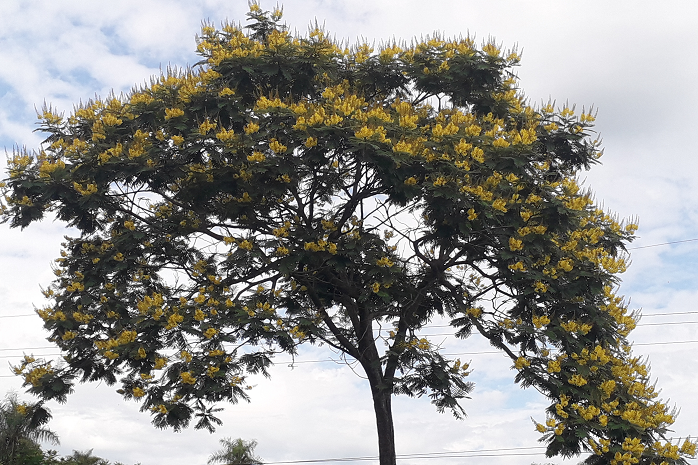Summer is a season of bright and vibrant colours all across Paraguay.
In the dry winter months many plants fade from their usual brightness. Also the country takes on a drier colour pallet as the grasses turn from green to brown.
This is reversed by the arrival of the spring rains. Their waters refresh the ground causing plants across the country to spring back into life.
By the time summer has arrived the regrowth is well underway. Summer also brings warm nights so plant life no longer needs to shut down for a few hours everyday.
The combination of water, heat and extended daylight hours bring forth a spate of rapid growth from the plant life of Paraguay.
Everything is in a hurry to grow and flower before it is crowded out by more vigorous neighbours. With such rapid growth changes in the plants can almost be detected from one day to another.
The first of the plants to take advantage of the improved growing conditions is the grass. During the dry winter months the vast grass lands which cover much of Paraguay loose their moisture and are replaced by huge expanses of dry brown straw.
The rains encourage regrowth. Very soon the new green shoots are pushing their way up through the old brown of the year before. Within a couple of weeks the fields have a green tint to them and before long are covered once more by s thick coat of lush green grass.
As the grass begins to grow so to do the wild flowers that grow amongst it. These wild plants are the first new flowers of the year.
They must rush to maturity. Displaying flowers and then developing seeds with great haste. Their life cycles need to be completed before the plants are crowded out by the rapidly thickening grass.
For a short while these wild flowers colour the grasslands. Expanses of blue, yellow, white or even purple flowers spread across the fields.
The vibrant show is a brilliant as it is brief. Within a couple of weeks the vast majority will have finished their life cycle and produced the seeds that will flower the following year.
Elsewhere the regrowth is equally rapid, but not so fleeting. Plants that are not endangered of being swamped by the grasses can take a little longer to develop their flowers and keep them for longer.
The tress that have shed their leaves and sat dormant throughout the winter are the first to spring back into life. With the first of the spring rains new leaves begin to develop. Soon the once bare branches are once more thickly coated with fresh green leaves.
Summer is the time for trees to display their colourful flowers. Some trees such as the lapacho do not wait that long. Flowering in spring before the new leaves unfold.
Most though put on the leaves needed to capture the sunlight needed for growth before turning their attention to flowers.
Once they do appear the flowers turn large trees into riots of colour. Some trees turn red and others yellow under a thick coating of flowers.
The flowers can often be seen from a great distance. Either they themselves may be large or they may be compound flowers formed by many smaller flowers growing together on a single stalk. Either way the effect is stunning and the canopy vibrant.
Flowering trees well above the grasses have no need to rush their growing cycle. As such they can keep their display for weeks. During this time new flowers constantly replace the old and pollinating insects have plenty of time to complete their work.
It is of course not just high in the trees and low amongst the grasses that Paraguay bursts into colour during the summer months.
Throughout the land all types of bushes and flowers display their wares at summer time.
Every garden across the land is full of a myriad of bright flowers. Large bright flower of every colour filling every flower bed and the delicate colours of orchids suspended from the trees above.
The many forms of cactus and bromelia also choose summer as the time to burst into flowers.
The effect is a vibrant and colourful land with nature spreading off in every direction. The ground in summer is carpeted with a rich and vibrant green above and amongst which are displayed all the other colours nature can produce.
And there is one final summer flower in Paraguay that cannot be overlooked. Summer is the time that the coco palms produce their flowers that will become fruits the next year.
These large yellow flowers are thickly scented and most commonly appear mid to late December. As such they have become a symbol of Christmas in Paraguay and something placed in front of every crib scene.
All though summer and into autumn Paraguay is filled with bright flowers. Some display for days and others for weeks. They cause every corner of the land to be filled with colour until the cold dark days of winter arrive.
Even then the colour is only drained from the land for a moment. The arrival of spring will begin the cycle a new as it has always done.


Recent Comments